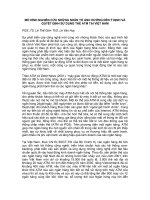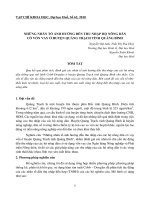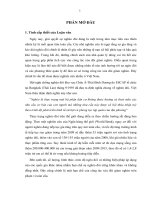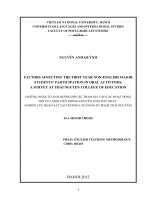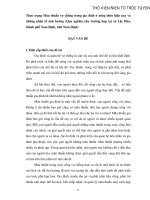Nghiên cứu những nhân tố ảnh hưởng đến động lực của sinh viên trong giờ học nói tiếng Anh. Nghiên cứu trường hợp với sinh viên năm nhất trường Đại Học Lao Động
Bạn đang xem bản rút gọn của tài liệu. Xem và tải ngay bản đầy đủ của tài liệu tại đây (1.32 MB, 69 trang )
VIETNAM NATIONAL UNIVERSITY, HANOI
UNIVERSITY OF LANGUAGES AND INTERNATIONAL STUDIES
FACULTY OF POST-GRADUATE STUDIES
TRẦN THỊ HUYỀN
AN INVESTIGATION INTO THE
FACTORSAFFECTING THE STUDENTS’
MOTIVATIONIN ENGLISH SPEAKING CLASSROOM: A
CASE STUDY ON THE FIRST YEAR STUDENTS AT
THE UNIVERSITY OF LABOR AND SOCIAL AFFAIRS.
NGHIÊN CỨU NHỮNG NHÂN TỐ ẢNH HƯỞNG ĐẾN ĐỘNG
LỰC CỦA SINH VIÊN TRONG GIỜ HỌC NÓI TIẾNG ANH. NGHIÊN
CỨU TRƯỜNG HỢP VỚI SINH VIÊN NĂM THỨ NHẤT TRƯỜNG
ĐẠI HỌC LAO ĐỘNG – XÃ HỘI
M.A. MINOR THESIS
Field: English Teaching Methodology
Code: 60.14.10
Hanoi, 2013
VIETNAM NATIONAL UNIVERSITY, HANOI
UNIVERSITY OF LANGUAGES AND INTERNATIONAL STUDIES
FACULTY OF POST-GRADUATE STUDIES
TRẦN THỊ HUYỀN
AN INVESTIGATION INTO THE
FACTORSAFFECTING THE STUDENTS’
MOTIVATIONIN ENGLISH SPEAKING CLASSROOM: A
CASE STUDY ON THE FIRST YEAR STUDENTS AT
THE UNIVERSITY OF LABOR AND SOCIAL AFFAIRS.
NGHIÊN CỨU NHỮNG NHÂN TỐ ẢNH HƯỞNG ĐẾN ĐỘNG
LỰC CỦA SINH VIÊN TRONG GIỜ HỌC NÓI TIẾNG ANH. NGHIÊN
CỨU TRƯỜNG HỢP VỚI SINH VIÊN NĂM THỨ NHẤT TRƯỜNG
ĐẠI HỌC LAO ĐỘNG – XÃ HỘI
M.A. MINOR THESIS
Field: English Teaching Methodology
Code: 60.14.10
Supervisor: Dr. Dương Thị Nụ
Hanoi, 2013
i
DECLARATION
This thesis is a presentation of my original research work. Wherever
contributions of others are involved, every effort is made to indicate this clearly,
with due reference to the literature, and acknowledgement of collaborative research
and discussions. The work was done under the guidance of Dr. Duong Thi Nu.The
research reported in this thesis was approved by University of Languages and
International Studies, Vietnam National University, Hanoi.
Hanoi, September 27
th
,2013
Tran Thi Huyen
ii
ACKNOWLEDGEMENTS
I would like to express my gratitude to all those who gave me the possibility
to make my thesis reach an end.
I would like to express my faithful gratitude to my supervisor, Dr. Duong Thi
Nu for her patient guidance, stimulating suggestions and encouragement throughout
my research.
I wish to thank all the staff members of the faculty of Post Graduate Studies,
University of Language and International studies, VNUfor providing me the best
environment to fulfill my thesis.
Especially, my sincere thanks send to my friend Truong Thi Thuy, M.A. for
her assistance in statistics as well as useful suggestions for writing this thesis.
I am greatly indebted my colleague at ULSA for their participation and
assistance without which this study could not have been successful.
Last but not least, I would like to express my special thanks to my loving
parents, my younger brother and my close friends who offered me their love, care,
support and encouragement so that I could accomplish my study.
Hanoi, September 2013
iii
ABSTRACT
This study aims to investigate the factors affecting students‟ motivation in
English speaking class room with the first - year students at the University of Labor
and Social Affairs (ULSA). In this study, 110 first-year students from different
faculties of ULSA were chosen as the subjects. A questionnaire and an interview
were used as the major data collection instruments. The data were computed and
analyzed. The major findings of the study showed that the factors affecting
students‟ motivation in English speaking classroom consist of four categories:
student- related factor, teacher – related factor, learning and teaching conditions and
course book. The study also demonstrated that among 4 factors, the student –
related factor was proved to be the most affected whereas teacher – related factor
was ranked as second. Based on the findings of the study, some discussion and
implications were made along with recommended suggestions for further research.
iv
LIST OF ABBREVIATIONS
CLT: Communicative Language Teaching
L2: Second Language
M: Mean
SD: Standard Deviation
SLA: Second Language Acquisition
SDT : Self – Determination Theory
ULSA: The University of Labor and Social Affairs
v
LIST OF TABLES
Table 1: Background information of participants
Table 2: Learner – related factor
Table 3: Teacher – related factor
Table 4: Teaching and learning condition
Table 5: Course book
Table 6: The comparison among 4 factors
vi
LIST OF FIGURES
Figure 1: Student – related factor
Figure 2: Teacher – related factor
Figure 3 : Teaching and learning condition
Figure 4 : Course book
Figure 5 : The comparison among 4 factors
vii
TABLE OF CONTENTS
DECLARATION i
ACKNOWLEDGEMENTS ii
ABSTRACT iii
LIST OF ABBREVIATIONS iv
LIST OF TABLES v
LIST OF FIGURES vi
TABLE OF CONTENTS vii
PARTA.INTRODUCTION 1
1. Statement of problem and the rationale for the study 1
2. Aims and objectives of the study 2
3. Scope of the study 3
4. Significance of the study 3
5. Method of the study 3
6. Organization of the study 4
CHAPTER 1. LITERATURE REVIEW 5
1.1. Theoretical background of motivation in second or foreign language
learning 5
1.1.1. The role of motivation in L2 learning 5
1.1.2. Motivation as seen from different theories and modes 6
1.1.2.1. Gardner‟s Socio- educational model of L2 acquisition 6
1.1.2.2. Deci & Ryan (1985): Self-Determination Theory 7
1.1.3. Definition of motivation in L2 acquisition 7
1.1.4. Types of motivation 8
1.4.1.1. Intrinsic and extrinsic motivation 9
1.4.1.2. Integrative vs. instrumental motivation 10
1.2. Factors affecting motivation in learning speaking English 12
1.2.1. Related conceptions 12
1.2.2. Studentrelated factors 14
viii
1.2.3. Teacher – related factors 15
1.2.4. Teaching and learning condition 17
1.2.5. Course book 18
1.3. Motivation in L2 speaking classroom 18
1.3.1. Related issues of speaking skill 18
1.3.1.1. Some concepts of speaking skill 18
1.3.1.2. Types of classroom speaking performance 19
1.3.2. Motivation in speaking classroom 20
1.3.2.1. Factors affecting students unwilling to speak in classroom 20
1.3.2.2. Some conditions for effective motivation in speaking 20
CHAPTER 2. RESEARCH METHODOLOGY 22
2.1. An overview of case study 22
2.2. Description and context of the study 22
2.3. Data collection instrument 24
3.1.1. Questionnaire for students 24
3.1.2. Interview for teachers 25
2.4. Data collection procedures and data analysis 25
CHAPTER3. RESULT AND DISCUSSION 27
3.1. Results 27
3.1.1. Data analysis of students‟ survey questionnaire and interview 27
3.1.1.1. Personal information of the students taking part in the survey 27
3.1.1.2. Student related factors 27
3.1.1.3. Teacher – related factor 30
3.1.1.4. Teaching and learning condition factor 32
3.1.1.5. Course book factor 33
3.1.1.6. The comparison among factors affecting students‟ motivation in
English speaking classroom 35
3.1.2. Data analysis of teacher interviews 36
3.2. Discussions of findings on factors that motivate students in English
speaking classroom 39
3.2.1. Student – related factor 39
ix
3.2.2. Teacher – related factors 41
3.2.3. Teaching and learning conditions 42
3.2.4. Course book 42
PART C. CONCLUSION 43
1. Conclusions 43
2. Pedagogical implications 43
3. Limitation 45
4. Suggestion for further research 45
REFERENCES 46
APPENDIX 1 I
APPENDIX 2 V
APPENDIX 3 IX
1
PARTA.INTRODUCTION
1. Statement of problem and the rationale for the study
No one remains to deny or to be suspicious of the role of English in our
society nowadays. It can be seen easily that the importance of this subject is
emphasized. Likewise, speaking skill is also paid more attention as a result of
increasing international communication. Despite the fact that many students are
exposed to English from the very early stages, their oral English level is deficient.
To integrate with the English community, the learners should be equipped with the
basic interactive skills such as to express themselves, to transfer the information or
to exchange the knowledge, culture, etc. For these demands, improving the
students‟ English speaking learning is becoming the key point.
As a teacher of English at ULSA (The University of Labor and Social
Affairs), I realized that the students (all are non English major students) are quite
passive in the oral English class. Their interactions are restricted in the speaking
lesson because some find it hard to follow the teacher‟s activities and some don‟t
get involved. Facing this situation, the researcher wonders whether the student‟s
motivation is the predictor of students‟ involvement and interest. Because
motivation colors and shapes students‟ involvement in learning and it stimulates
feelings that students associate with these experiences (Winne, 1985), why the
students have the low motivation of learning oral English and how to solve this
problem become the necessity and emergency among the educators.
As a fact, motivation arose the students‟ performance in the oral English
classroom. To learn the target language, motivation seems to be very crucial in the
development of speaking skill. Without the sufficient motivation, even individuals
with the most remarkable abilities cannot accomplish long-term goals.
2
There have been numerous studies conducted by the international teachers
and researchers to investigate factors that may affect motivation in L2. Among all,
some typical scholars are Deci and Ryan in Sefl determination Theory, Williams
and Burden‟ L2 motivation framework (1997) or Dornyei‟s extended motivational
framework
However, in Vietnam, to the researcher‟s knowledge, although there have
been some research works on motivation for learning English, most of them focused
on investigating the motivation for learning English among students and factors
affecting students‟ motivation (Cao, 2011; Dinh, 2011; Ha, 2008; Ngo, 2008; Pham,
2009). There have also been some researches investigating factors affecting
motivation in speaking classroom ( Luu, 2008) . However, the subjects of the study
are the high school students.
For these above reason, I would like to conduct a study “An investigation
into the factors affecting the students’ motivation in English speaking
classroom: A case study on the first year students at the University of Labor and
Social Affair.”
2. Aims and objectives of the study
The study aims at investigating the factors affecting motivation in English
speaking classroom among the first year students at ULSA. Specifically, the project
is carried out with the following purposes:
- To explore what factors motivate students‟ oral English proficiency.
- To suggest motivational strategies to stimulate learners in speaking skill.
With the mentioned aim of study, the researcher attempts to answer
twoquestions as follows:
3
1. What are the factors motivating students in learning English speaking?
2. What motivational strategies / technique can be applied in oral English
classroom?
3. Scope of the study
Although the motivation is of great impulse to learner‟s academic
achievement, this study just makes a deep insight in only narrower area: the oral
English proficiency. Moreover, within the framework of the study, the author just
focuses on the case of the 1st year students at ULSA instead of all the students.
4. Significance of the study
The study is designed to provide statistical evidence about the real
motivation of students in the speaking English classroom. It is believed that the
study will raise a proper awareness for the teachers and educators about students‟
motivation in language learning and provide them an appropriate tool to predict
students‟ speaking English learning‟s outcomes. Through this prediction, teachers
can come to reasonable decisions about teaching methods, materials design,
measures of evaluation as well as classroom activities to raise students' interests and
motivation in oral English classroom learning.
5. Method of the study
The study was carried by using mixed methods for data collection and
analysis. Survey questionnaires were used to gather information and evidence from
students. The interviews for teachers were used to find out their ideas about factors
affecting students in speaking English classroom.
4
6. Organization of the study
This study consists of three parts: Introduction, Development and
Conclusion.
Part A. - Introduction - discusses the reasons for carrying out this study,
defines the specific purposes, research questions, and the scope of the study. The
significance and the outline of the study are also presented.
Part B – Development- consists of 3 chapters:
Chapter 1 - Literature Review - provides an overview of literature on the
issues of motivation in second or foreign language learning especially motivation in
speaking English. Some related issues of speaking English are also presented.
Chapter 2 - Methodology - discusses the methodology for this study and
the procedure for carrying out the research such as the selection of the sample, the
data collection procedures, and the data analysis.
Chapter 3 - Results and Discussion - reports the results of the data
analysis and discussion.
Part C. – Conclusion- proposes some implications based on the findings of
the study. This is followed by the limitations of the work, and some suggestions for
further studies. The last section in this chapter is the conclusion to the whole study.
Following Part C is references listing all reference books or materials
directly or indirectly quoted in the study. The final section of the thesis contains the
appendices that show all documents serving this research.
5
PART B. DEVELOPMENT
CHAPTER 1. LITERATURE REVIEW
1.1. Theoretical background of motivation in second or foreign language
learning
1.1.1. The role of motivation in L2 learning
The term “motivation” was intensively investigated by many scholars and
researchers in the area of psychology and education such as Gardner, Dornyei.
There has been an immerse consensus that motivation is seen the critical
determinant associated with learners‟ L2 achievement. Gardner and Lambert (1959)
found that aptitude and motivation were the two factors most strongly associated
with learners' L2 achievement. Subsequently, in Gardner‟s Socio educational model
of SLA, he hypothesized that L2 learners with positive attitudes toward the target
culture and people will learn the target language more effectively than those who do
not have such positive attitudes. Furthermore, motivation is regarded as the core
proponent of students‟ involvement in language learning. Dornyei (2009) in a book
“ motivation and a vision of knowing second language” emphasized the importance
of motivation to the students‟ participation in the classroom lesson as follows
“Indeed, motivation provides the primary impetus to initiate second/foreign (L2)
learning and later the driving force to sustain the long and often tedious learning
Process.” Motivation in his concept devises a great force not only to foster learners‟
temporary interest but also uphold that passion till the boring lesson.
6
1.1.2. Motivation as seen from different theories and modes
1.1.2.1. Gardner’s Socio- educational model of L2 acquisition
The model was laid the foundation by the work of Gardner and Lambert
(1959). In the1960s, the model was developed with his book about the role of
attitude and motivation in second language learning. Since then, it has undergone
many revisions ( i.e. in 1979, 1985 and 2001). Gardner, in many versions of this
model emphasized that L2 acquisition unlike the studying of the other subject in
classroom “involves the acquisition of skill or behavior pattern which are the
characteristic of the another cultural community.” The model presented four class of
variables affecting L2 acquisition: social milieu, individual differences, second
language acquisition context and outcomes. In the social milieu, the cultural belief
which refers to people‟s belief to the culture of target language‟s community and
the environment plays an important role to leaner‟s language proficiency.
In the variable “individual difference”, four factors relating to learner‟s
achievement including intelligence, aptitude, motivation and situational anxiety
(Gardner, 1979). Gardner ( 1985) modified this model by using two different
concepts called integrative motive and instrumental orientation. In which,
integrativeness is seen as an interest in the second language group, the learner
shows an openness and identification with the target language community and their
culture. Instrumental orientation allows the learner to gain something from
acquiring the language, for practical reasons, such as in the case of getting a job or
enhancing one‟s education. The former orientation concerns a positive disposition
toward the L2 group and the desire to interact with and even be assimilated into
valued members of that community. The latter is the utilitarian counterpart of
integrative orientation, pertaining to the economic and practical advantages of L2
proficiency, such as a better job or a high salary. Gardner (1985)tends to hold that
an integrative orientation is a particularly important source of motivation since it is
rooted in the personality of the learner. Additionally, it is likely to exert its
7
influence over an extended period and sustain learning efforts over the time, which
is necessary for attaining language learning success. In contrast, an instrumental
orientation is based on the advantages that can arise if a language is known.
Therefore, an instrumental motive, which is dependent on external rewards, is less
effective than an integrative motive.
1.1.2.2. Deci & Ryan (1985): Self-Determination Theory
Deci and Ryan had a big contribution to the formal emergence of self-
determination theory with the publication of “intrinsic motivation and self-
determination in Human behavior” (1985). In this theory, they present a crucial
distinction between two types of motivation: intrinsic motivation and extrinsic
motivation. Intrinsic motivation is regarded as the internal force which urges
learners to be involved in the performance of a task for its own sake. More
specifically, it stresses more on the volition and engagement in the “process of
accomplishing some task or goal”. In contrast, extrinsic motivation is the pursuit of
external reward; therefore it focuses more on the outcome of task rather than
process.
Self – determination theory comprises of 5 mini theories as a result of many
experimental research about motivation. A prominent feature of this theory is to
present factors affecting these two above types of motivation. Among three basic
psychological needs supporting motivation, autonomy and competence are seen to
be major factors in fostering intrinsic motivation.
1.1.3. Definition of motivation in L2 acquisition
Motivation as seen from some theories is the affective variable in second
language learning. As mentioned above, there have been many researchers and
theories about motivation which has a big correlation with language learning
process. Equivalently, many various attempts have been made to define second
language acquisition motivation. However, theorists define motivation differently.
8
Gardner was one of the pioneering researchers who laid the foundation to
the investigation of motivation. In a research called The role of attitudes and
motivation (1985,p.21), he refers motivation as “the combination of effort plus
desire to achieve the goal of learning the language plus favorable attitudes towards
learning the language”. Specifically, motivation in his concepts consist of the
following components: a goal, a desire to attain that goal and the positive behavior
to reach the goal. Motivation in his socio educational model (1985) includes some
complex variables affecting this such as integrativeness and attitude. However, this
definition achieved many criticism despite his great contribution to “ motivation in
SLA” when focused much on the integrative motive; i.e., emphasize more on the
directed effort the individual learners make rather than the other factors.
From Dörnyei‟s (1998, p. 117) point of view, motivation is defined as the
“process of whereby a certain amount of instigation force arises initiates actions,
and persists” as long as there is no other forces weakening it until the planned goals
were reached. In other words, motivation can be seen as a force that makes a person
to initiate action, and to keep on until they reach the goals.
Ellis (1994), in an overview of research on motivation, claimed that
motivation affects the extent to which language learners persevere in learning, what
kinds of behavior they exert, and their actual achievement.
1.1.4. Types of motivation
As mentioned above, there are many theorists shed light on motivation;
consequently, the conceptions of problem are complex and abundant. Likewise,
kinds of motivation are variously classified. However, two typical following
mainstreams of classification will be focused.
9
1.4.1.1. Intrinsic and extrinsic motivation
Intrinsic and extrinsic are two opposing terms of motivation. Such
classification has appeared in numerous studies (Covington & Kimberly, 2001;
Deci & Ryan, 1985; Noels, et al., 1999; Noels, Clément, & Pelletier, 2001; Noels,
Pelletier, Clément, & Vallerand, 2003; Schmidt, et al., 1996). One of the best
known approaches that reveals this classification of motivation in language learning
is Deci & Ryan‟s (1985) self-determination theory. Deci and Ryan in “ Self
determination theory” (1985) clearly sort out these two prominent types of
motivation as follows . Intrinsic motivation is defined as doing something truly
enjoyable and satisfying. The root of this motivation is emerged from inner side.
People who are intrinsically motivated engaged in activities or tasks volitionally.
Deci and Ryan also stress the role of intrinsic motivation in education in the way it
“ results in high quality – learning and creativity”. The learners participate in the
task not to accomplish it but to investigate it for their own sake. Moreover, the
feeling of competence and self – determination are two significant factors fostering
them to pursue the goal.
In contrary, extrinsic motivation are regarded as the external variable.
While intrinsic motivation is “self – endorsed”, extrinsic motivation associated with
the situation that one feels “externally propelled into action”. Deci & Ryan (1985)
refer extrinsic motivation to the motivation to learn something in order to arrive at
an instrumental end such as earning a reward or avoiding a punishment. In other
word, learners perform a task for other reasons such as reward or the worry about
the punishment rather than the truly passion.
Intrinsic motivation is obviously seen as positive and significant
phenomenon verse extrinsic motivation. Social psychological research has indicated
that extrinsic rewards can diminish and lead a subsequent reduction in intrinsic
motivation. Unlike some theories consider extrinsic motivation non- autonomous,
Self – Determination Theory proved that extrinsic motivation can vary greatly in its
10
relative autonomy (Ryan & Connell, 1989; Vallerand, 1997). For example, students
who do their homework because they personally grasp its value for their chosen
career are extrinsically motivated, as are those who do the work only because they
are adhering to their parents' control ( Deci and Ryan ). Both examples involve
instrumentalities rather than enjoyment of the work itself, yet the former case of
extrinsic motivation entails personal endorsement and a feeling of choice, whereas
the latter involves compliance with an external control.
Cognitive Evaluation Theory ( CET) presented by Deci and Ryan (1985)
pointed out that a feeling of competence and autonomy will enhance intrinsic
motivation. Moreover, in SDT, they also emphasize that issue of autonomy versus
control.
1.4.1.2. Integrative vs. instrumental motivation
Another distinction of motivation as integrative and instrumental
orientation is also a common one in this field. It was early introduced in Gardner‟s
studies (Bernaus & Gardner, 2008; Gardner, 1985; Gardner & Lambert, 1972;
Gardner & MacIntyre, 1991, 1992, 1993) and then advocated in other research.
Crookes &Schmidt (1991) identified integrative motivation as the learner's
orientation with regard to the goal of learning a second language. It means that
learner's positive attitudes towards the target language group and the desire to
integrate into the target language community. Similarly, integrative orientation is
defined as “a sincere and personal interest in the people and culture represented by
the other language group” (Lambert, 1974, p. 98).
Finegan (1999:568) further demonstrated the role of integrative motivation
that „integrative motivation typically underlines successful acquisition of a wide
range of registers and a native like pronunciation‟. Obviously, integrative
motivation is a key component in assisting the learner to develop some levels of
11
proficiency in the language. It becomes a necessity in order to operate socially in
the community and become one of its members.
Generally, integrative orientation refers to a learner‟s desire to learn more
about the cultural community of the target language or to assimilate to some degree
in the target community. In the other words, Integrative orientation refers to a desire
to increase the affiliation with the target community.
In contrast ,instrumental motivation underlies the goal to gain some social
or economic reward through L2 achievement. Gardner and Lambert ( 1972) in his
motivation theory referred instrumental motivation to the potential utilization gain
of L2 proficiency. It refers to learners‟ desire to learn the language in order to
accomplish some non-interpersonal purpose such as to pass an exam or to advance a
career or getting a good salary. Like while, instrumental motivation, according to
Lambert (cited in Ellis, 1997), is something which concerns “the practical value and
advantages of learning a new language” ) Ur (1996, p. 276).
Specified this point by characterizing this kind of motivation as “the wish to
learn the language for purposes of study or career promotion, and the desire to
obtain something practical or concrete from the study of a second language”.
While both integrative and instrumental motivations are essential elements
of success, it is integrative motivation which has been found to sustain long-term
success when learning a second language (Taylor, Meynard and Rheault 1977; Ellis
1997; Crookes et al 1991). In many researches of Gardner, he repeatedly
emphasized the importance of integrative motivation in second language acquisition
rather than instrumental one. He explained that if learners were instrumentally
motivated, when the goal has been achieved, students would lose motivation to
continuing learning.
12
However, instrumental motivation is gradually identified. Moreover, it
cannot be denied that at school context, majority of students approach instrument
motivation more frequently than integrative one. Lukmani (1972) found that an
instrumental orientation was more important than an integrative orientation in non-
westernized female learners of L2 English in Bombay. She further stated that the
social situation helped to determine both what kind of orientation learners had and
what kind was most important for language learning.
Noels, Clément, & Dörnyei (1994) agreed with this classification of
motivation. However, the researchers concluded that while integrative motivation is
perhaps more important in a second language context, an instrumental motivation
maybe more important in other situations where language is learnt as a foreign
language. One area where instrumental motivation can prove to be successful is in
the situation where the learner is provided with no opportunity to use the target
language and therefore, no chance to interact with members of the target group.
Brown (2000) makes the point that both integrative and instrumental
motivations are not necessarily mutually exclusive. Learners rarely select one form
of motivation when learning a second language, but rather a combination of both
orientations.
1.2. Factors affecting motivation in learning speaking English
1.2.1. Related conceptions
The significance of motivation in SLA has been confirmed in many
researches, therefore, the search for factors arousing as well as undermining
motivation is in need. Many L2 motivation framework such as Deci and Ryan in
Sefl determination Theory, Williams and Burden‟ L2 motivation framework (1997)
or Dornyei‟s extended motivational framework have referred to different variables
that affect students „motivation. Each framework has distinct approach to the
13
matter. Specifically, Deci and Ryan in SDT present 5 mini theories with briefly
introduction of phenomenon relating to factors affecting human motivation. He
proposes that the psychological needs, namely those for autonomy, competence and
relatedness are satisfied and fully supported, people will become more self –
motivated.
Regarding to Williams and Burden‟ L2 motivation framework (1997),
motivation is a mixture of internal and external influences that contribute greatly to
the motivational process. Internal influences include intrinsic interest of activity,
perceived value of activity, sense of agency, mastery, self-concept, attitudes, other
affective states such as confidence and anxiety, developmental age and gender. On
the other hand, external influences include, significant others such as parents,
teachers; and peers, the nature of interaction with significant others, the learning
environment and the broader context.
Domyei's work has been considered as one of the most influential
contemporary motivational constructs in L2. In his model (2001), he introduced
three levels of motivation: language level, learner level and learning situation level.
Language level focus on motive related to some L2 aspects like the culture it
conveys, the com- munity in which it is spoken, and the potential usefulness of
proficiency in it.
The learner level involves individual characteristics that learners have in
their learning process. It consists of need for achievement and self- confidence, the
latter encompassing various aspects of language anxiety, perceived L2 competence,
attributions about past experiences, and self-efficacy.
The learning situation level: is associated with (l) course-specific
motivation, which refers to syllabus, the teaching materials, teaching methods and
learning tasks. (2) teacher-specific motivation which concerns the motivational
impact of the teacher's personality, behavior and teaching style (controlling or
14
autonomy supporting) (3) group-specific motivation which includes goal-
orientedness, group cohesiveness, classroom goal structure, norm and reward
system.
It can be inferred that even three typical researchers have different view to
approach the matter, it seems that they all come to an agreement with the following
classification of factors affecting students‟ motivation.
1.2.2. Studentrelated factors
Intelligence& aptitude: According toLightbown & Spada (1999:52), the
term intelligence implying the performance on certain kinds of tests. Whereas
aptitude as Dornyei denifine is “language learning ability”(2005:32). Lightbown &
Spada pointed out that aptitude include 4 components:(1) the ability to identify and
memorize new sounds, (2) the ability to understand the function of particular words
in sentences, (3) the ability to figure out grammatical rules from language samples
and (4) the ability to memorize new words (1999: 53).
Personality
The factor personality is seen the prominent component contributing to the
success in second language learning.
Lightbown and Spada (1999:56) discussed a number of personality
characteristics that have a great influence on the success of second language
learners: extroversion, inhibition, self- esteem, empathy, dominance, talkativeness
and responsiveness . Moreover, he also emphasize that it‟s not the personality alone
which dominate the outcome of second language learning.
Learning strategies

